Amphiboles (silicates): Apophyllite
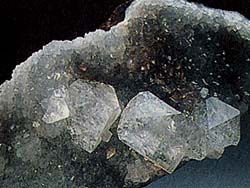 Diagnostic card.
Diagnostic card.
In the photo there are transparent crystals. Below: green crystals of apophyllite on columnar Heylandite. Both samples are from Pune (India).
K Ca 4 F (Si 4 O 10 ) 2 * 8 H 2 O
Tsingonia tetragonal
Hardness 4,5-5
Specific weight 2.32-2.37
Cleavage perfect along the base
Crack irregular
Color is colorless, differently colored
Color in powder white
Glitter glass, mother-of-pearl

 Two extreme members are distinguished in composition: hydroxyl-apophyllite and fluorophilic apophyllite. Apophyllite crystals are very common and very diverse in appearance. They are flattened, some very thin in the form of plates (in the section mostly rectangular), others with corners cut off by four facets, others resemble a cube whose peaks are cut off by small triangular faces of a tetragonal pyramid.
Two extreme members are distinguished in composition: hydroxyl-apophyllite and fluorophilic apophyllite. Apophyllite crystals are very common and very diverse in appearance. They are flattened, some very thin in the form of plates (in the section mostly rectangular), others with corners cut off by four facets, others resemble a cube whose peaks are cut off by small triangular faces of a tetragonal pyramid.
Also quite common are crystals in the form of a square bipyramid with pointed tops resembling an octahedron, or an elongated prism, or pinacoid with a strongly developed base. Crystals can be of considerable size; Be colorless and transparent, or white and translucent and opaque. The most elegant and interesting for collecting are pink, green and azure blue.
Singonia, symmetry class, space group. Tetragonal; 4 / m2 / m2 / m; P4 / mnc. The parameters of a unit cell and the number of formula units. A = 8.960, c = 15.78; Z = 2. Crystal structure. Instead of the right planes formed by the joined six-membered rings that are present in the layered silicates described above, the structure of the apophyllite consists of regular four-membered rings joined together into irregular eight-membered rings that form layers with the formula (Si4O10) 4 usual for phyllosilicates.
Habit. Usually it forms crystals; A combination of {110}, {101} and {001}; The crystals look cubic, composed of a cube and an octahedron, but the correct symmetry breaks the cleavage in one direction and the difference in gloss between basal planes and other facets. Also tabular, flattened parallel {001}; Prism usually with a shading parallel to the c axis. Cleavage. By {001} perfect, by {110} is unclear.
Gloss and light transmission. Pearlescent on {001}, on other planes glass. Transparent to translucent. Optical properties. Anisotropic, biaxial (+). The refractive indices are: no = 1.531-1.536, nе = 1.533 - 1.538. Low birefringence. Diagnostic signs. Shape of crystals, cleavage and association.
Diagnostic signs.
In the flame of the candle it is stratified and melts, forming a light glass; When heated in a glass tube, loses water, which is deposited on the walls. Under the action of hydrochloric acid decomposes, forming a gel-like precipitate. Colorless or white; In some cases slightly colored in pink, green or yellow.
Origin.
Apophyllite is a typical mineral of hydrothermal origin. It mainly occupies voids in the rocks of the basalt and the composition close to it.

Apophyllite, rare earth. Prudyansky K-r, Cherkasy region., Ukraine, CIS. Photo: © А.А. Evseev.
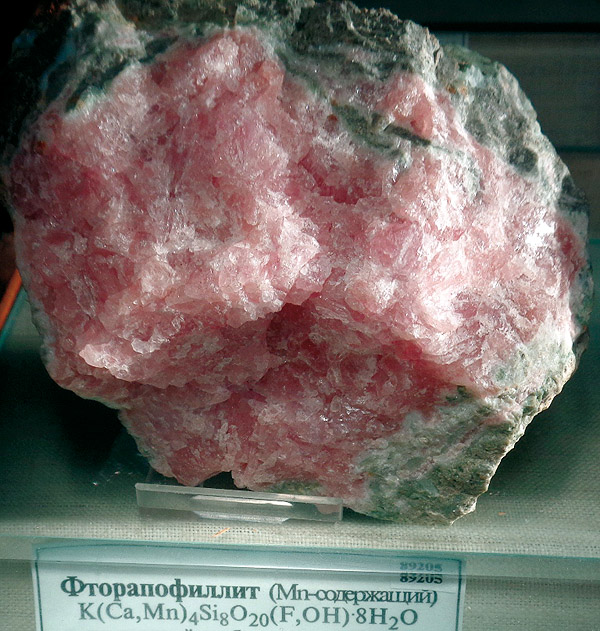
Fluorophosphite (manganese Mn-containing), dark-pink coarse aggregate
In the cavity of the modified andesite. Persia, to the SW of Akhaltsikhe, Georgia, the CIS. Photo: © А.А. Evseev.
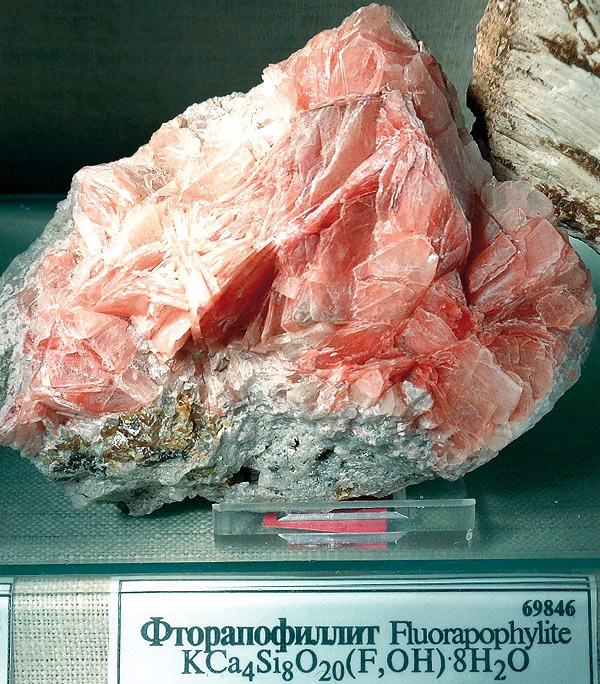
Fluoropophyllite. Bear Island, Kandalaksha Bay, White Sea, Russia, CIS.
Rosette-shaped aggregates of lamellar crystals. Photo: © А.А. Evseev.
Place of Birth.
Magnificent specimens, sometimes emerald green, came from the Poona area, adjacent to Bombay, in India. In Italy, notable samples are known from the Alpe de Siusi (Bolzano province) and the surroundings of Moro (province of Trento). Less often, apophyllite in the form of small but elegant crystals is found in the cracks of Montecoño-Majora basalt in Vicentino.


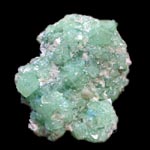
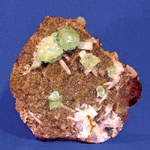
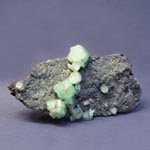
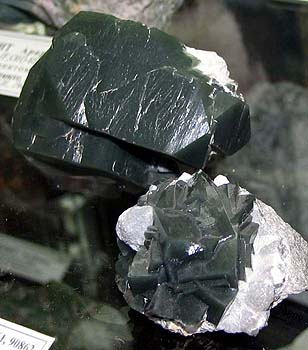

Hydroxyapophyllite. The skin of two dark-green thick-plate crystals of hydroxyapophyllite stained with inclusions of actinolite. Lomontite, okenit. Hydroxyapophyllite. A group of prismatic crystals on a gyrolite crust. Quarry for the town of Maly Kermen (Pervomaisky = Trudolyubovsky kr), near the village of Trudolubovka, to SW from Simferopol, Crimea, Ukraine. Photo: © А.А. Evseev.
- Ghetchellit - "New Almaden blend" - arsenide and antimony sulfide (modern sulfosol)
- Antimony is a toxic metal (semimetal) , widely used in metallurgy, medicine and engineering
- Zirconium - a rare and undiscovered metal and the most dangerous precious stone in oxide and salt
- Gold - yellow dangerous and poisonous metal of modern accurate digital and cable technologies
- Sulfur is a golden-yellow toxic substance and a sign of active volcanic activity
- Cadmium is an undisputed toxic silvery metal unknown to a wide range of people
- Lead - a toxic gray imitator of metallic silver and toxic metal blende
- Arsenic is a classic poison of medieval and modern poisoners and medicine in medicine
Poisonous and radioactive dangerous stones and minerals
** - poisonous stones and minerals (mandatory check in the chemical laboratory + explicit indication of toxicity)
** - radioactive stones and minerals (mandatory check on the standard dosimeter + ban on open sales in case of radioactivity exceeding 24 milli / g / h + additional measures of population protection)
Catalog of minerals and semi-precious stones of the world by groups
** - poisonous stones and minerals
** - radioactive stones and minerals


Comments
When commenting on, remember that the content and tone of your message can hurt the feelings of real people, show respect and tolerance to your interlocutors even if you do not share their opinion, your behavior in the conditions of freedom of expression and anonymity provided by the Internet, changes Not only virtual, but also the real world. All comments are hidden from the index, spam is controlled.